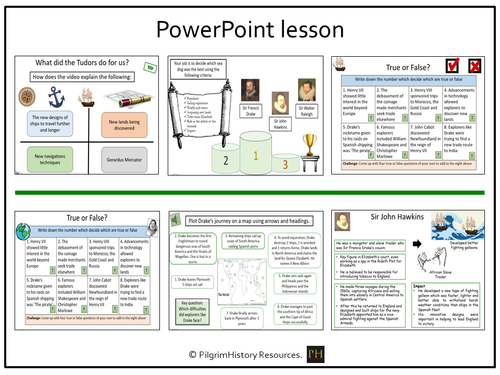


The Tudors
The aim of this lesson is to decide which Tudor explorer deserves the most recognition in a seafaring ‘Hall of Fame’.
Students are led through the journeys and discoveries of sailors in Elizabethan England from the Cabot brothers to Gerardus Mercator and his brilliant Atlas. (This was to give the navigator a map, where a line of constant bearing would cross all meridians at the same angle)
The sailors achievements and the problems they encountered are given through learning activities such as a play your cards right, video evidence, a true or false quiz and a plotting exercise of Sir Francis Drake’s circumnavigation of the globe on a blank world map.
The main task is to analyse and evaluate the achievements of Drake, Hawkins and Raleigh with differentiated resource materials.
Students are given specific criteria to judge this before ultimately deciding who had the greatest impact and should be given the most recognition for Elizabethan exploration.
The lesson concludes with a literacy key word game.
The lesson is enquiry based with a key question using a lightbulb posed at the start of the lesson and revisited to show the progress of learning.
The resource includes suggested teaching strategies, retrieval practice, differentiated materials and comes in Powerpoint format if there is a wish to adapt and change.
Get this resource as part of a bundle and save up to 30%
A bundle is a package of resources grouped together to teach a particular topic, or a series of lessons, in one place.
Elizabeth I Bundle
This bundle follows the Key Stage 3 National Curriculum - the development of Church, state and society in Britain 1509-1745 including the Elizabethan religious settlement and conflict with Catholics (including Scotland, Spain and Ireland). The aims of this bundle are to know and understand how peoples' lives were shaped by Elizabeth, how she dealt with the threats to her rule and how her legacy lives on today as one of our greatest ever Queens. Students will learn and understand key historical skills. These include historical concepts such as continuity and change with a focus on the Elizabethan Poor Law, the causes and consequences of the Elizabethan Settlement, similarities and differences in her portraits and the significance of the defeat of the Armada as well as exploration and the theatre. The 11 lessons are broken down into the following: L1 The young Elizabeth L2 The Elizabethan Settlement (free resource) L3 Elizabeth and her favourites (free resource) L4 Elizabeth and the problem of marriage L5 Elizabeth and her portraits L6 How did Elizabeth deal with Mary, Queen of Scots? L7 Famous explorers (Drake, Hawkins and Raleigh) L8 The Spanish Armada L9 Elizabeth, poverty and the Poor Law L10 Elizabethan Theatre and the Globe Each lesson comes with suggested teaching and learning strategies and are linked to the latest historical interpretations and debate from the BBC and other sources. The lessons are fully adaptable in PowerPoint format and can be changed to suit. I have included a couple of free lessons to give an idea of what is being offered. Although this bundle is aimed at Key Stage 3, it is ideal if you are studying Elizabeth I for GCSE as it covers the main themes, concepts and skills required for the new specifications.
Tudors Complete Bundle
This bundle follows the Key Stage 3 National Curriculum - the development of Church, state and society in Britain 1509-1745. I have designed these lessons to be challenging and engaging as well as fun and enjoyable. The aims of this bundle are to know and understand how peoples’ lives were shaped by the Tudors from Henry VII to Elizabeth I, how they changed the course of British history and why we are still fascinated by their lives today. Students will learn and understand key historical skills throughout; for example, the concepts of continuity and change with the Wars of the Roses and the accession of Henry VII to the throne, key historical terms such as dissolution, Catholic and Protestant and vagrancy, recognising the causes and consequences of Henry’s break with Rome, analysing the significance of the Black Tudors, Edward VI and Elizabeth I as well as evaluating sources and interpretations such as the reputation of Mary 1. The 20 lessons are broken down into the following: L1 The War of the Roses L2 Henry VII L3 An introduction to Henry VIII L4 Did Henry VIII break with Rome for love? L5 Did Henry VIII break with Rome for faith? L6 Did Henry VIII break with Rome for money? L7 The dissolution of the monasteries L8 The sinking of the Mary Rose L9 Edward VI L10 Bloody Mary L11 Black Tudors L12 The young Elizabeth L13 The Elizabethan Settlement (free resource) L14 Elizabeth and the problem of marriage L15 Elizabeth and her portraits L16 How did Elizabeth deal with Mary, Queen of Scots? L17 Famous explorers (Drake, Hawkins and Raleigh) L18 The Spanish Armada L19 Elizabeth, poverty and the Poor Law L20 Elizabethan Theatre and the Globe Due to TES restrictions on Bundles, the introduction to the Tudors, which is a free lesson, must be downloaded separately. Each lesson comes with suggested teaching and learning strategies and are linked to the latest historical interpretations and debate from the BBC and other sources. The lessons are fully adaptable in PowerPoint format and can be changed to suit. I have included a free lesson to give an idea of what is being offered. Although this bundle is aimed at Key Stage 3, it is ideal if you are studying the Tudors for GCSE as it covers the main themes, concepts and skills required.
Something went wrong, please try again later.
This resource hasn't been reviewed yet
To ensure quality for our reviews, only customers who have purchased this resource can review it
Report this resourceto let us know if it violates our terms and conditions.
Our customer service team will review your report and will be in touch.